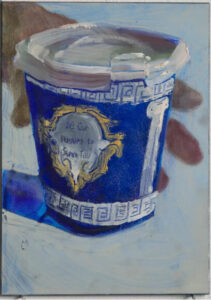Art and finance collided in an unexpected and provocative act as a cryptocurrency entrepreneur made headlines by consuming a piece of art worth $6.2 million in Hong Kong. The artwork, Comedian, by Italian artist Maurizio Cattelan, consisted of a banana duct-taped to a wall and had already stirred controversy in the art world since its debut. The entrepreneur’s bold act raises questions about the intersection of value, ownership, and the ephemeral nature of both modern art and wealth in the digital age.
The Artwork: A Commentary on Value
Maurizio Cattelan’s Comedian was first displayed at Art Basel Miami in 2019 and quickly became a cultural sensation. The banana, a commonplace item, was transformed into a multimillion-dollar statement on consumerism, capitalism, and the absurdity of art valuations. Despite—or perhaps because of—its simplicity, the piece was sold to collectors for astronomical sums, sparking debates about the commodification of art.
By eating the artwork, the entrepreneur—known for his investments in blockchain technology and NFTs—escalated this discourse. His act not only destroyed the physical piece but also questioned the very concept of permanence and value in an age where digital art and cryptocurrencies often defy traditional frameworks.
The Entrepreneur’s Perspective
The unnamed buyer, a vocal proponent of decentralized finance, claimed his decision was an intentional statement about the transient nature of both wealth and art. “The banana is like crypto,” he said. “It holds value, but that value is volatile and ultimately subjective.”
His comment aligns with the ethos of blockchain culture, where value is often derived from collective belief rather than intrinsic worth. In consuming the banana, he paralleled the unpredictable volatility of cryptocurrency markets, where millions can be gained or lost in seconds.
Public Reaction
The act, performed during a private art exhibition in Hong Kong, drew mixed reactions. Critics labeled it a publicity stunt, arguing it trivialized the art world and reduced Comedian to a mere spectacle. Others, however, applauded the audacious move as a fitting critique of the modern art market’s excesses.
Social media exploded with commentary, with some drawing parallels to the NFT phenomenon, where digital “ownership” is valued over tangible assets. Memes comparing the eaten banana to lost Bitcoin fortunes quickly trended online, further amplifying the event’s reach.
Implications for Art and Wealth
The entrepreneur’s actions underscore the shifting definitions of ownership and value in an era dominated by speculative assets. Like an NFT linked to a blockchain, Comedian challenged traditional ideas of art’s permanence. By consuming the fruit, the buyer extended the artwork’s narrative, emphasizing its performative and conceptual dimensions.
The incident also speaks to the broader cultural conversation about wealth in the cryptocurrency age. It highlights the blurred lines between financial investment, artistic expression, and social critique. In destroying the banana, the entrepreneur not only consumed a piece of art but also amplified its message: value is as fleeting as a piece of fruit, but its impression can linger indefinitely.
This bold act ensures that Cattelan’s Comedian will remain a point of contention and reflection in art history, long after the banana itself has been digested.
No comments yet.







